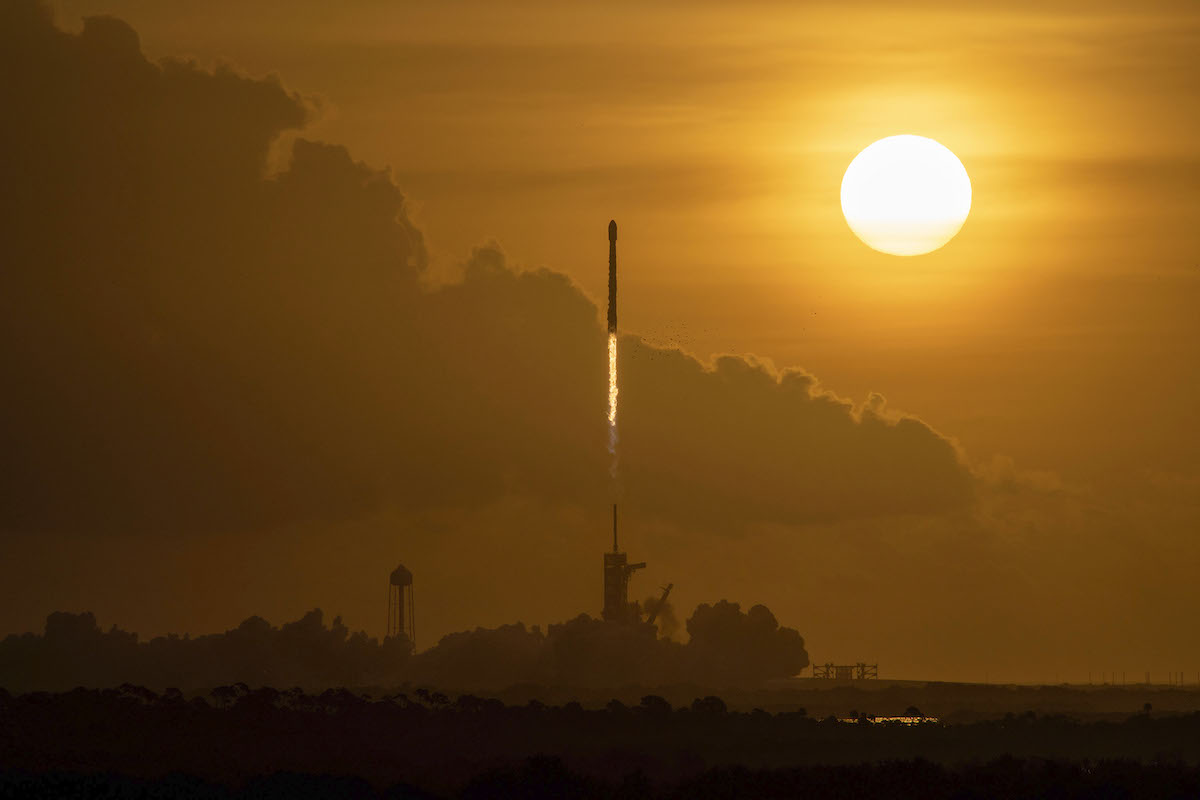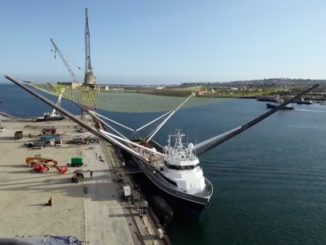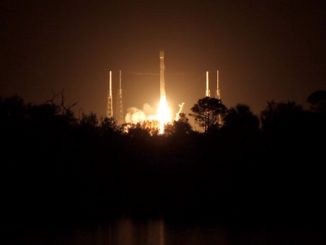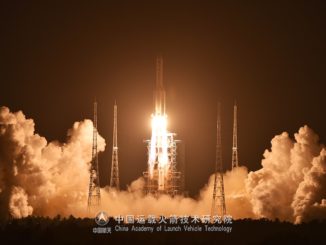
Sixty more SpaceX Starlink broadband satellites rocketed into orbit Tuesday from the Kennedy Space Center, breaking a streak canceled launch attempts at the Florida spaceport in recent weeks and nudging the Starlink network closer to reaching a wider population.
Nine Merlin 1D engines flashed to life and powered the Falcon 9 launcher off pad 39A at the Kennedy Space Center at 7:29:34 a.m. EDT (1129:34 GMT) Tuesday, a few minutes after sunrise on Florida’s Space Coast.
The nine kerosene-fueled engines steered the 229-foot-tall (70-meter) rocket toward the northeast from the spaceport with 1.7 million pounds of thrust. Two-and-a-half minutes later, the first stage booster shut down and jettisoned to begin a descent toward SpaceX’s drone ship positioned in the Atlantic Ocean around 400 miles (630 kilometers) northeast of Cape Canaveral.
The Falcon 9’s first stage nailed the landing — the 61st successful recovery of a SpaceX rocket booster — as the second stage injected the mission’s 60 Starlink satellites into orbit.
The reusable booster used on Tuesday’s mission completed its third trip to space and back, following flights earlier this year to help send NASA astronauts Doug Hurley and Bob Behnken into orbit on a Crew Dragon capsule in May, and a launch in July with South Korea’s Anasis 2 military communications satellite.
One half of the two-piece, clamshell-like payload fairing on Tuesday’s mission was also making its third flight. A recovery boat in the Atlantic caught the reusable fairing half again Tuesday as it descended under a parachute.
While SpaceX’s fleet was at work recovering rocket hardware in the Atlantic, the Falcon 9’s upper stage ignited a second time to place the 60 Starlink payloads into an on-target near-circular orbit around 170 miles (275 kilometers) above Earth, with an inclination of 53 degrees to the equator.
The 60 flat-panel satellites separated from the Falcon 9’s upper stage around 8:31 a.m. EDT (1231 GMT). A live video feed from the rocket showed the payloads drifting away into space.
The 60 spacecraft, built by SpaceX in Redmond, Washington, were expected to unfurl solar panels and activate krypton ion thrusters to begin raising their altitude to roughly 341 miles (550 kilometers), where they will begin providing broadband service.
Here’s a replay of this morning’s launch of a Falcon 9 rocket from the Kennedy Space Center. It’s carrying 60 more Starlink broadband satellites into orbit for SpaceX.
Continuing coverage: https://t.co/I0aLt9FqRS pic.twitter.com/uq3a7a9HbB
— Spaceflight Now (@SpaceflightNow) October 6, 2020
The successful launch Tuesday occurred on SpaceX’s fifth try to send the next 60 Starlink satellites into orbit.
A launch attempt Sept. 17 was called off due to poor sea conditions in the downrange recovery zone for the Falcon 9’s reusable first stage booster. Then SpaceX scrubbed a Sept. 28 launch attempt at T-minus 31 seconds because of bad weather at the launch site.
SpaceX tried again to launch the Starlink mission Thursday, Oct. 1, but an unexpected reading from a ground sensor prompted an automatic abort at T-minus 18 seconds. A fourth launch attempt Monday ended just before fueling of the Falcon 9 rocket as rain showers and thunderstorms moved over the Kennedy Space Center.
Cumulus clouds from nearby rain showers threatened to scrub Tuesday’s countdown, but the weather held off long enough for the Falcon 9 to fire off into a clear sky.
Amid the Starlink launch attempts in recent weeks, teams at Cape Canaveral have tried to send two other missions into orbit.
A different Falcon 9 rocket was supposed to launch Friday night from pad 40 at Cape Canaveral Air Force Station with a GPS navigation satellite for the U.S. Space Force. But a potential problem associated with an engine on the rocket prompted an automated abort just two seconds prior to liftoff. SpaceX has not set a new target launch date for the GPS mission.
Meanwhile, United Launch Alliance has tried to launch a Delta 4-Heavy rocket with a U.S. government spy satellite from pad 37B at Cape Canaveral since late August. Problems with launch pad equipment have delayed the launch more than a month, and a countdown Sept. 30 was again stopped seven seconds before takeoff. ULA has also not announced a schedule for the next Delta 4-Heavy launch attempt.
With Tuesday launch, SpaceX has deployed 775 Starlink satellites to date, including two prototype platforms and 773 satellites on 13 Falcon 9 launches since May 2019.
SpaceX plans to operate an initial block of around 1,500 Starlink satellites in orbits 341 miles above Earth. The company, founded by billionaire Elon Musk, has regulatory approval from the Federal Communications Commission to eventually field a fleet of up to 12,000 small Starlink broadband stations operating in Ku-band, Ka-band, and V-band frequencies.
Siva Bharadvaj, a spacecraft operations engineer at SpaceX who hosted the company’s launch webcast Tuesday, said the Starlink network is “still very much a work in progress.”
“Starlink is a constellation of satellites that can provide high-speed, low-latency internet all over the globe, particularly in remote and rural areas where connectivity is often limited and sometimes completely unavailable,” Bharadvaj said.
Private beta testing of the Starlink internet network started earlier this year in Washington, allowing SpaceX to begin collecting latency statistics and speed tests.
On Sept. 28, the Washington Military Department announced it was using the Starlink internet service as emergency responders and residents in Malden, Washington, recover from a wildfire that destroyed much of the town.
Happy to have the support of @SpaceX’s Starlink internet as emergency responders look to help residents rebuild the town of Malden, WA that was overcome by wildfires earlier this month. #wawildfire pic.twitter.com/xUSQOjcT4T
— WA Emergency Management 😷 (@waEMD) September 28, 2020
The Washington emergency responders set up a Starlink ground terminal in Malden. SpaceX said in Tuesday’s launch webcast that the Starlink network is providing internet service to residents of the town.
“Starlink will be a revolution in connectivity, especially for remote regions or for emergency services when landlines are damaged,” tweeted Elon Musk, SpaceX’s founder and CEO.
The 60 new satellites launched Tuesday will allow SpaceX to expand its beta testing into a public phase with broader participation, Musk said.
“Once these satellites reach their target position, we will be able to roll out a fairly wide public beta in northern US & hopefully southern Canada,” Musk tweeted. “Other countries to follow as soon as we receive regulatory approval.”
Email the author.
Follow Stephen Clark on Twitter: @StephenClark1.



